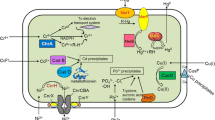Abstract
The objective of the present study was to obtain by mutation and selection techniques bacterial strains capable of removing heavy metals at high efficiency. Four of the bacteria most promising in metal uptake, Staphylococcus aureus, Bacillus Sphaericus, B. licheniformis and Arthrobacter sp. were selected after isolation from water heavily polluted with heavy metals. Two mutagenic agents were used: U.V. irradiation at 245nm (physical) and 1% ethidium bromide (chemical). Optimum conditions for metal removal by most of the tested bacteria were: pH 9, 50°C and 200rev/min agitation speed. Induction of mutation both physically or chemically resulted in mutants that were superior over their wild types in removing heavy metals under investigation. The highest removal efficiencies (REs) achieved were in the following order: Cd(89.9–100%); Cr(87.3–99.7%); Zn(47.7–100%); Cu(40.8–84.7%); Pb(40.2–51%); Fe(17.5–28.7%); Ni(13.8–23.9%) and finally Co(17.2–18.4%). Using mixed cultures of the wild and the selected mutants enhanced the RE(s) of some metals compared to those obtained by individual species, and the time required to achieve the highest RE was reduced.
Similar content being viewed by others
References
Amer, A.A. 1997 Biotechnological studies on mineral bioleaching from polluted aquatic media. M.Sc. Thesis. Department of Bioscience and Technology, Institute of Graduate Studies and Research (IGSR), Alexandria University, Egypt.
Bhide, J.V., Dhakephalkar, P.K. & Paknikar, K.M. 1996 Microbiological process for the removal of Cr(VI) from chromate-bearing cooling tower effluent. Biotechnology Letters, 18, 667–672.
Chan, P. & Ting, Y.P. 1995 Effect of heavy metals uptake on the electrokinetic properties of Saccharomyces cervisiae. Biotechnology Letters 17, 107–112
Corder, S.L. & Reeves, M. 1994 Biosorption of Ni in a complex aqueous waste streams by cyanobacteria. Applied Biochemistry and Biotechnology, 45/46, 847–859.
Eland, R.P. & Espenshade, M.A. 1976 The role of microbial genetics. In Industrial Microbiology. Miller, B.M., & Litsky, W. (eds.), pp. 192–256, McGraw-Hill Book Co., New York. ISBN 0–07042142–0.
Falla, J., & Block, J.C. 1993 Binding of Cd2+, Ni2+, Cu2+ and Zn2+ by isolated envelops of Pseudomonas fluorescens. FEMS Microbiology Letters, 108, 347–352.
Fontana, A., Bidenne, C., Ghommigh, C., Guiraud, J.P. & Vezinhei, F. 1992 Study of the flocculation of Saccharomyces diastaticus NCYC 625. Journal of the Institute of Brewing, 98, 401–407.
Gopalan, R., Swaminathan, T., Punekar, N.S. & Veeramani, H. 1993 Study of iron removal from ferric citrate medium by pure and mixed cultures of iron resistant microbes. Biotechnology Letters, 15, 433–438.
Kung, A.H.C. & Lee, B.T.O. 1973 The isolation and survival characterization of radiation and chemical mutagen sensitive mutants of Pseudomonas aeruginosa. Mutation Research, 20, 175–190.
Wong, P.K. & Kwork, S.C. 1992 Accumulation of Nickel ion (Ni2+) by immobilized cells & Enterobacter species. Biotechnology Letters, 14, 629–634
Woods, D. & Rawlings, D.E. 1989 Bacterial leaching and biomining. In: A Revolution in Biotechnology Mark, J.L. (ed.). pp. 82–93. Cambridge University Press, Cambridge. ISBN 0–52132749–0
Zhang, C., Liu, S., Logan, J., Mazumder, R. & Phelps, T.J. 1996 Enhancement of Fe(III), Co(III) and Cr(VI) reduction at elevated temperatures by a thermophilic bacteria. Applied Biochemistry and Biotechnology, 57/58, 923–932.
Author information
Authors and Affiliations
Rights and permissions
About this article
Cite this article
El-Bestawy, E., Abou El-KHeir, E., Abd El-Fatah, H. et al. Enhancement of bacterial efficiency for metal removal using mutation techniques. World Journal of Microbiology and Biotechnology 14, 853–856 (1998). https://doi.org/10.1023/A:1008827830024
Issue Date:
DOI: https://doi.org/10.1023/A:1008827830024




